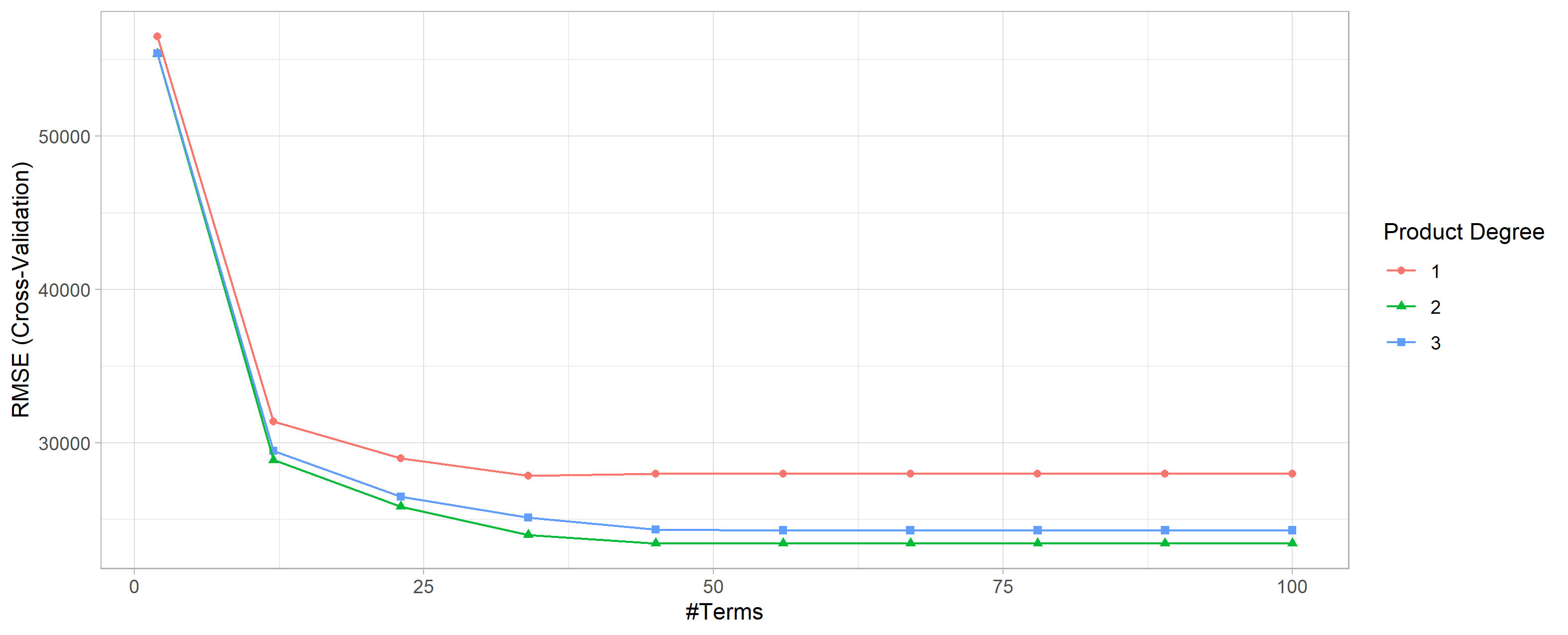Tuning Process
There are two important tuning parameters associated with our MARS model:
degree: the maximum degree of interactions, where rarely is there any benefit in assessing greater than 3-rd degree interactions.nprune: Maximum number of terms (including intercept) in the pruned model, where you can start out with 10 evenly spaced values.
# create a tuning grid
hyper_grid <- expand.grid(
degree = 1:3,
nprune = seq(2, 100, length.out = 10) |> floor()
)
head(hyper_grid)## degree nprune
## 1 1 2
## 2 2 2
## 3 3 2
## 4 1 12
## 5 2 12
## 6 3 127.0.3 Caret
# Cross-validated model
set.seed(123) # for reproducibility
cv_mars <- train(
x = subset(ames_train, select = -Sale_Price),
y = ames_train$Sale_Price,
method = "earth",
metric = "RMSE",
trControl = trainControl(method = "cv", number = 10),
tuneGrid = hyper_grid
)
# View results
cv_mars$bestTune
## nprune degree
## 16 45 2
cv_mars$results |>
filter(nprune == cv_mars$bestTune$nprune,
degree == cv_mars$bestTune$degree)
# degree nprune RMSE Rsquared MAE RMSESD RsquaredSD MAESD
# 1 2 45 23427.47 0.9156561 15767.9 1883.2 0.01365285 794.2688ggplot(cv_mars)+
theme_light()
cv_mars$resample$RMSE |> summary()
# Min. 1st Qu. Median Mean 3rd Qu. Max.
# 20735 22053 23189 23427 24994 26067
cv_mars$resample
# RMSE Rsquared MAE Resample
# 1 23243.22 0.9387415 15777.98 Fold04
# 2 23044.17 0.9189506 15277.56 Fold03
# 3 23499.99 0.9205506 16190.29 Fold07
# 4 23135.62 0.9226565 16106.93 Fold01
# 5 25491.41 0.8988816 16255.55 Fold05
# 6 21414.96 0.9202359 15987.68 Fold08
# 7 21722.58 0.9050642 14694.66 Fold02
# 8 26066.88 0.8938272 16635.14 Fold06
# 9 20735.28 0.9274782 14226.06 Fold10
# 10 25920.58 0.9101751 16527.20 Fold097.0.4 Tidymodels
The main benefit of using tidymodels to perform 10-CV is that you can stratify the folds, which can be very useful taking in consideration that the target variable is right-skewed.
ggplot(ames_train, aes(Sale_Price))+
geom_histogram(fill = "blue", alpha = 0.6)+
theme_light()
- Define the model to train
mars_model <-
mars() |>
set_mode("regression") |>
set_engine("earth") |>
set_args(nprune = tune(),
degree = tune())- Define the recipe to use
mars_recipe <-
recipe(Sale_Price ~ ., data = ames_train) |>
step_dummy(all_nominal_predictors()) |>
prep(training = ames_train) - Create a
workflowobject to join the model and recipe.
mars_wf <-
workflows::workflow() |>
workflows::add_recipe(mars_recipe) |>
workflows::add_model(mars_model)- Create the folds with
rsample
set.seed(123)
ames_folds <-
vfold_cv(ames_train,
v = 10,
strata = Sale_Price)- Getting metrics for each resample
mars_rs_fit <-
mars_wf |>
tune::tune_grid(resamples = ames_folds,
grid = hyper_grid,
metrics = yardstick::metric_set(yardstick::rmse))- Check the winner’s parameters
mars_rs_fit |>
tune::show_best(metric = 'rmse', n = 3)
# nprune degree .metric .estimator mean n std_err .config
# <dbl> <int> <chr> <chr> <dbl> <int> <dbl> <chr>
# 1 2 1 rmse standard 25808. 10 1378. Preprocessor1_Model01
# 2 2 2 rmse standard 25808. 10 1378. Preprocessor1_Model02
# 3 2 3 rmse standard 25808. 10 1378. Preprocessor1_Model03
final_mars_wf <-
mars_rs_fit |>
tune::select_best(metric = 'rmse') |>
tune::finalize_workflow(x = mars_wf)
# ══ Workflow ════════════════════════════════
# Preprocessor: Recipe
# Model: mars()
#
# ── Preprocessor ────────────────────────────
# 1 Recipe Step
#
# • step_dummy()
#
# ── Model ───────────────────────────────────
# MARS Model Specification (regression)
#
# Engine-Specific Arguments:
# nprune = 2
# degree = 1
#
# Computational engine: earth